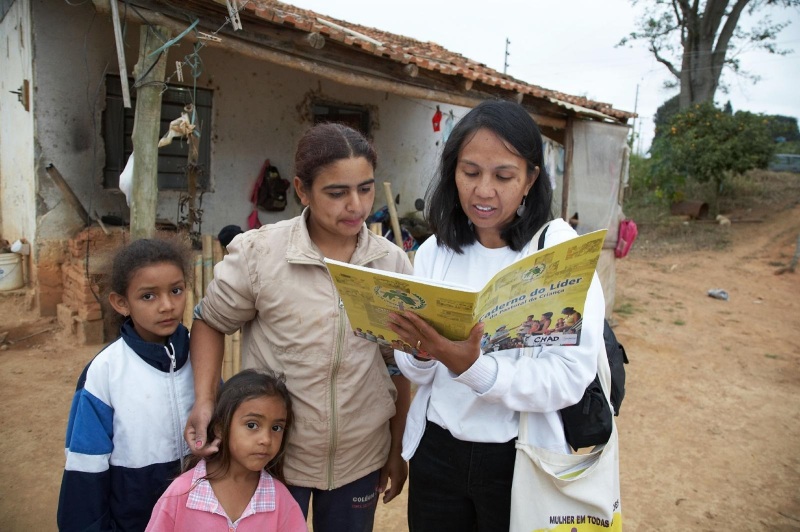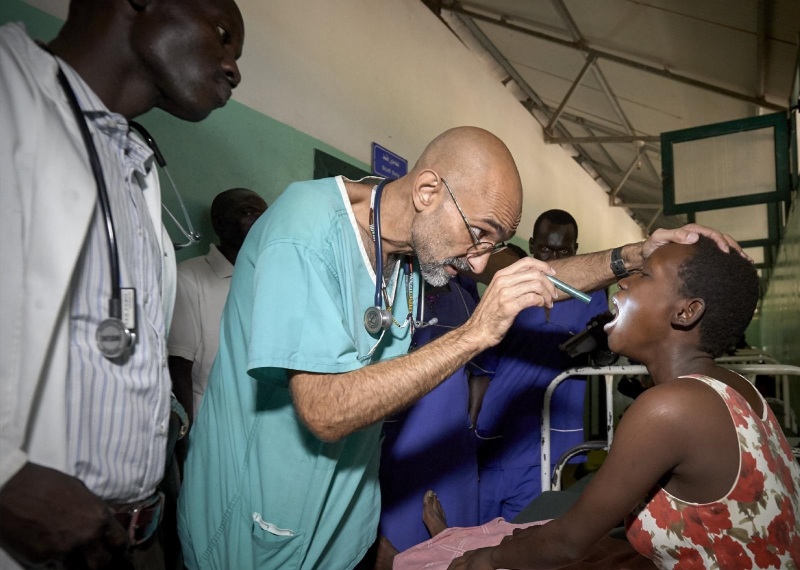
At home or abroad, mission work involves 'radical transformation' in Christ, says US missions expert
By Gina Christian
10/21/2024
Ahead of World Mission Sunday — which the Catholic Church celebrates on the second to last Sunday in October, and which in 2024 falls on Oct. 20 — OSV News spoke with Kevin Foy, executive director of the United States Catholic Mission Association, on current perspectives and trends in mission work.

Angel Mortel is pictured is pictured in a file photo visiting the
home of 23-year-old Sandra, 23, and her children in Ibiuna,
Brazil, near São Paulo. The Catholic Church will mark World
Mission Sunday Oct. 20, 2024.
(OSV News photo/Sean Sprague, courtesy Maryknoll)
USCMA, which traces its roots to a 1949 conference held by the U.S. Catholic bishops, provides networking, formation and advocacy opportunities for church leaders as they work to create a culture of mission. Among USCMA's organizational members are the U.S. Conference of Catholic Bishops' Office of National Collections and Secretariat of Cultural Diversity in the Church, as well as numerous religious orders and Catholic dioceses throughout the nation.
This interview has been edited for length and clarity.
OSV News: What does mission look like right now for U.S. Catholics, and for Catholics globally?
Kevin Foy: There are a few ways to think about mission. One relates to The Pontifical Mission Societies and the celebration of World Mission Sunday, and the areas where the church doesn't have the full resources, personnel, and infrastructure to serve the pastoral needs of all the faithful. And I think when you look at it through that lens, especially when it comes to clergy, then the U.S. has sort of become a "mission territory," especially with the number of foreign-born clergy and women religious. (Editor's note: Close to 90% of U.S. dioceses rely on foreign-born clergy and religious, while a 2017 report found that there were at least 4,000 foreign-born women religious serving in the U.S.)
The question I think for that aspect in terms of mission is, "Are these folks always trained the way a missionary would be in terms of interculturality and evangelization within a certain context?" In addition, how are they finding community as missionaries, especially when they're serving? I've heard a lot from priests in rural and remote U.S. dioceses where they may be the only person from not only their country, but their region of the world. Sometimes they're only the only person of color serving where they're at. And so I think there are a lot of challenges for them as missionaries.
Also, when we talk about mission, there's an important distinction to be made about mission territories. Mission dioceses aren't dioceses primarily where people are necessarily being sent to do mission. Rather, those are dioceses where the local clergy, the local religious congregations, local people of faith are trying to be a light of God and a light of faith in their own home context, and they are seeking international partnerships to find the resources that they can get from donations and collections to serve those needs that are all around them.

States, examines a patient during rounds in 2018 at the
Mother of Mercy Hospital in Gidel, a village in the Nuba
Mountains of Sudan.
OSV News file photo/Paul Jeffrey
I think in the U.S. context — and this has been a slow growth from the Second Vatican Council — there's a tension of mission, a sense that the mission of God is everywhere, and so we're called to be missionaries everywhere. However, "mission" does mean certain things. It means seeking encounter within new contexts. It means crossing cultural boundaries or certain barriers. If you look at Matthew 25:31-46 (the judgment of the nations, when Jesus Christ rewards those who cared for the poor and suffering, while condemning to eternal punishment those who failed to do so), you ask, "How are you going forth? How are you pushing out of your comfort zone and countering the present crisis, where maybe you weren't having that encounter before?"
So I think that questions in the U.S. church are, "Where is that calling for people? Are we really pushing ourselves to listen to the call of God, to say, 'Where are the new territories, especially where Christ is suffering in people's realities and experiences?'" And I think as the church deals with its own problems in the U.S. — fewer people identifying as Catholic, fewer funds, etc. — there is that question of how we make mission a primary call for people, even as we're nervous about the parochial reality in the United States.
OSV News: How do interculturality and mission work together?
Foy: I think that notion of discovering Christ is what missionaries would call inculturation, moving with the culture to see where the Lord is working, where the reign of God is struggling to break through. Being trained in interculturality helps you to enter into the culture and appreciate it, so you can minister to people, but then also engage in that discovery.
I think a lot of church history has seen interculturality and inculturation shunted to the side, especially prior to Vatican II. We've learned and have had to deal with the fallout.
For pastors, one question is how people communicate in the cultural context you're working in. How do you read between the lines with what people are doing or aren't doing? How do they relate to clergy? What are their expectations of what that relationship would look like, versus the role of the laity? I think that's all very culturally coded and informed. And if you really want to be a pastor and a minister to any culture, you have to do the endless work of trying to learn how people tend to move through the world. You're a shepherd, you're helping them move, so you need to know how the sheep prefer to move — how they relate to the world, so that you can be successful and fruitful in serving them as a missionary, a pastor or whatever your role in ministry is.

Sister Veronica, a member of the Little Sisters
of St. Francis, shows a representative of the
U.S. International Development Finance
Corporation produce from the Divine Mercy
Green Farm her order operates in Nakuru, Kenya.
OSV News photo/Handout, Missio Invest,
Pontifical Missionary Societies in the United States
OSV News: With religious disaffiliation rising, how do Catholics in the U.S. serve as "home missionaries," and re-evangelize the people in their own nation?
Foy: Well, that's the million-dollar question for the church right now. For me, based on what I've seen and what I've experienced, I would say the encounter with Christ needs to be named for people.
I think people have to have the experience of discomfort — get out of their comfort zone. Sit down for a meal with the folks who come to the food pantry, and then reflect on the Gospels and other Scriptures. And then say, "What did I feel during this (encounter)? Where do I see God present in all of this?"
People need a language of faith and discernment to interpret life as they're living it. Invite people into dialogue, and ask, "What is your life? What are you experiencing? What are your struggles? And how does this Gospel passage or this understanding of who Jesus is ... help you to interpret what's going on?"
The missionary witness is that lived embodiment of who Jesus is. And it's not a witness of you doing it to prove a point. It's a witness of you being so transformed by the love of God that it radically transforms the way you relate to people and others.
Witness is not just that your parish has a food pantry, or that you sometimes do service at the homeless shelter. Those are important parts of it, but witness is that radical transformation of who you are and how you relate to others in everything that you do. And then that creates the opportunity to start talking about, "Well, my faith is the reason that I do this. ... I'm doing what I'm doing because I believe Jesus sends me forth, and ... I'm going to encounter Christ, and then respond to who Christ is and to his suffering in the world around me."
- - -
Gina Christian is a multimedia reporter for OSV News. Follow her on X, formerly Twitter, @GinaJesseReina.
-
